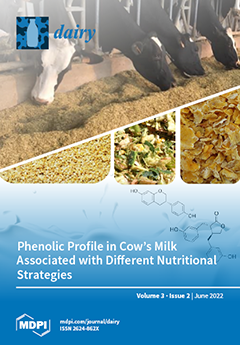The objectives of this study were to (1) determine the effect of exogenous fibrolytic enzyme derived from
Trichoderma reesei on dry matter (DM) and neutral detergent fibre (NDF) degradability of whole plant faba bean silage (Snowbird), (2) evaluate the effects of fibrolytic enzyme (FETR) on DM and NDF degradation kinetics of whole plant faba bean silage, and (3) compare the difference between in the vitro approach (Daisy
II incubation method) and the in situ assay-biological approach (nylon bag technique) in the determination of degradability of dry matter (DMD) and neutral detergent fibre (NDFD). The fibrolytic enzyme from
Trichoderma reesei was a mixture of xylanase and cellulase. The whole plant faba bean silage was treated with seven doses of fibrolytic enzyme, with 0 as a control and 0.25, 0.5, 0.75, 1, 1.25 and 1.5 mL of FETR/kg DM of silage. The results obtained from the in situ method show that fibrolytic enzyme cubically (
p < 0.05) affected DMD and quadratically (
p < 0.01) affected NDFD with increasing level of enzyme application. In vitro DM and NDF degradability were quadratically and cubically (
p < 0.01) affected by the increasing dosage of enzyme. Correlation analysis between the in situ assay-biological approach and the In vitro Daisy
II approach showed a strong correlation (r = 0.98,
p < 0.01) on overall DMD and also a satisfactory relationship (r = 0.84,
p < 0.01) was found on overall NDFD. The enzyme application showed a great impact on NDF rumen degradation kinetics by decreasing the undegradable fraction and increasing the potential degradable fraction and the effective degradable content of fiber. The washable (W) and potential degradation fraction (D) were linearly (
p = 0.05) increased by the enzyme treatments. Therefore, the undegradable fraction was linearly decreased (
p = 0.05) with increasing dosage of enzyme. Both bypass (BNDF) and effective degradable NDF (EDNDF) were cubically (
p = 0.05) affected by fibrolytic enzyme. In conclusion, the exogenous fibrolytic enzyme derived from
Trichoderma reesei highly impacted rumen degradation characteristics and degradability of whole plant faba bean silage and could be used to improve fibre digestion of whole plant faba silage in dairy cows.
Full article





